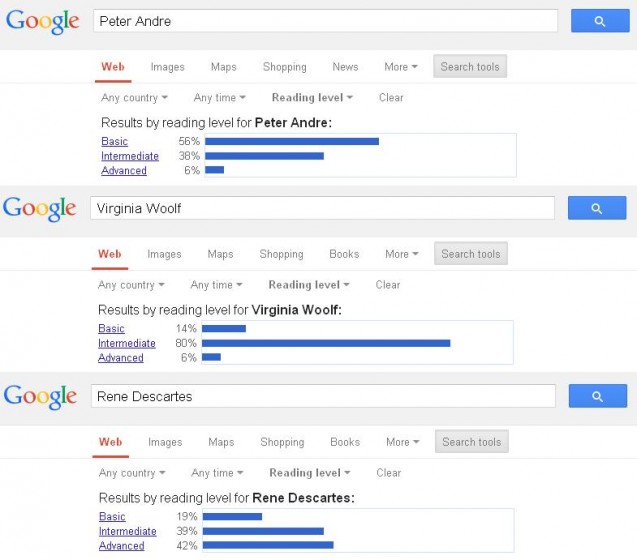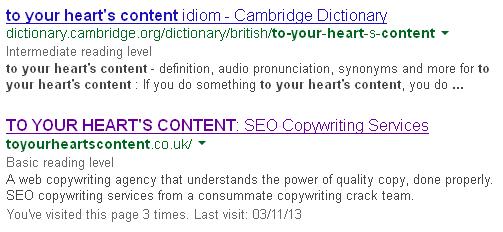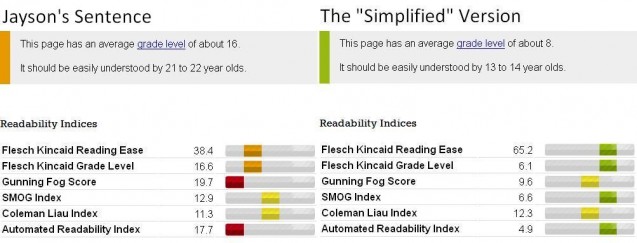I first came across the Flesch Reading Ease Test thanks to a combination of pride and annoyance. Messing around with Yoast’s WordPress plugin, I was confronted by the following message:
“The copy scores 68.9 in the Flesch Reading Ease test, which is considered OK to read.”
“OK to read?” I thought, “How dare you?” So, fueled by a heady mix of disbelief and irritation, I set out to learn more about this presumptuous little test and why it didn’t recognize that my content was, frankly, super stellar. The results were interesting and spoke volumes about why many outdated approaches to “SEO content” need to change in the Hummingbird age. Allow me to elaborate…
What is this Flesch test thing?
First things first, let’s just clear up what this test is. SEJ has highlighted a few readability tests in the past and the Flesch Reading Ease Test is just one of them. It was developed to gauge how easy it is to read a piece of text, using a simple (but not very sexy-looking) formula:
206.835 – 1.015 (total words/total sentences) – 84.6 (total syllables/total words)
As a word nerd (not a numbers whiz), this doesn’t make much sense to me either. Yet what it boils down to is actually very simple:
- More words per sentence = less readable
- More syllables in a word = less readable
- Fewer words in a sentence = more readable
- Fewer syllables in a word = more readable
Under the tyranny of the Flesch Reading Ease Test, short sentences comprised of monosyllabic words are rated as the most readable. Meanwhile, long sentences made up of polysyllabic words are considered the least readable.
Why does it matter?
I may have a personal bee in my bonnet about this test, but why does it matter to you and your SEO practices? Well, it transpires that readability is a ranking factor – and that Google have quite a neat little tool all set up and ready to gauge the readability of your content. Take a look at the page-level ranking factors in last May’s handy infographic. Grammar and spelling, along with readability, all have an effect on your page rank.
Equally, if the chaps over at Yoast think that it’s a factor worth including in SEO page analysis, there’s probably something to it…
It’s not entirely clear what test Google uses to rate readability, but they’re obviously using something. Just take a look at this advanced search function:
As you can see, users can choose to filter their results according to the readability level and choose to annotate search results with each website’s score:
How this affects ranking – and to what degree – is unclear. But keeping things short, sweet, and monosyllabic is likely to be in a website’s favor.
Or is It?
The “short and sweet”, “lowest common denominator” sentiment is not a new thing. Even away from the web, writers and students are frequently advised to “Keep It Simple Stupid”. Writing for the widest possible audience makes a certain amount of sense, but is there really any merit in it?
Well, yes and no. I’m just one copywriter, yet, in my humble opinion, there’s a lot to be said for knowing your audience, using a little common sense and not patronizing your demographic. If you write for the lowest common denominator across the board, you run the risk of alienating, boring, and irritating your target readership.
For instance, if you’re selling retro sweets to a broad market, this approach is fine. However, if you’re writing to engage clever people with an interest in online marketing (just like your good selves), then it’s not always such a good idea.
Example Time!
Let’s look at how this works in practice. I’ve taken the first sentence from Jayson DeMer’s helpful post on content creation to demonstrate. Here’s Jayson’s version:
“One of the effects of the rise of popularity in content marketing has been a surge in content curation; the practice of aggregating similar content into one place in an attempt to create new value.”
As you can see, this is a long, complex sentence, with plenty of polysyllabic words; aggregating, curation, popularity etc. Now, here’s a radically simplified version:
“Content curation puts different content in one place. Content curation is done to add value for users. This is done more and more. This is because content marketing is growing more popular.”
Now, according to read-able.com’s tests, my horrible, simplified version is more readable. But let’s be honest, it flat-out isn’t. It explains less clearly, it’s clunky and an all-round horrible reading experience. So much for “readability”. Point proven!
The Take Home Message
As we’ve seen, readability for search engines and readability for real human beings are two very different animals. While ‘robot readability’ is a ranking factor, it is just one factor among hundreds. Bounce rates are a big deal, too! If your visitors take one look at your plodding text before running for the hills, this is going to have an impact on your place in SERPs.
So how should you approach readability when writing for the web?
Write for Readers, not Robots
 Image credit: Steve Rainwater. Used under license.
Image credit: Steve Rainwater. Used under license.Here’s the grand finale: In a Hummingbird world, it’s far more important to provide a high-quality, engaging and target market-appropriate experience. Quick, techie fixes and SEO shortcuts are increasingly pointless. When you’re writing, forget about search engines and just write for your audience (make sure you know your sector and target market inside out first though!). You’ll convert more, get shared more and enjoy a more authoritative reputation as a result. Make sure your content is cracking, then worry about SEO value.
As for the Flesch Reading Ease Test, I think you can safely disregard any little Yoast messages which underrate your excellent content. Monosyllabic, five word sentences my be technically easier to read, but they do next to nothing for genuine readability, let alone audience engagement. So next time you’re writing up some hot new site copy or penning an industry-shaking blog: do it your way, for your target market and don’t let a robot tell you how to write.
Featured image credit: sarah5 via Depositphotos









